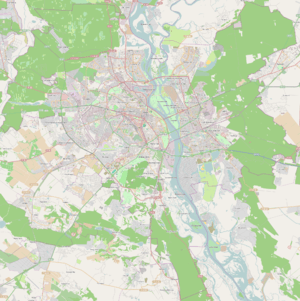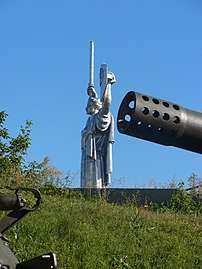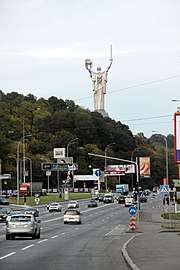Motherland Monument
The Motherland Monument (Ukrainian: Батьківщина-Мати, romanized: Batkivshchýna-Máty, Russian: Родина-мать) is a monumental statue in Kiev, the capital of Ukraine. The sculpture is a part of the National Museum of the History of Ukraine in the Second World War.[1]
| Батьківщина-Мати | |
.jpg) | |
 Location in Ukraine Kiev | |
| Coordinates | 50.426521°N 30.563187°E |
|---|---|
| Location | Pechersk, Kiev, Ukraine |
| Designer | Yevgeny Vuchetich, Vasyl Borodai |
| Material | steel |
| Height | 102 m (335 ft) |
| Opening date | 9 May 1981 |
| Dedicated to | Motherland |
| Website | Official webpage |
Description
The stainless steel statue stands 62 m (203 ft) tall upon the museum main building with the overall structure measuring 102 m (335 ft) including its base and weighing 560 tonnes. The sword in the statue's right hand is 16 m (52 ft) long weighing 9 tonnes, with the left hand holding up a 13 by 8 m (43 by 26 ft) shield with the State Emblem of the Soviet Union. Initially the image of the statue was drawn by Vutchetich from Ukrainian painter Nina Danyleiko,[2][3] after the design was taken over by Borodai from another Ukrainian sculptor Halyna Kalchenko, a daughter of the Prime Minister of Ukraine Nikifor Kalchenko.[4]
The memorial hall of the Museum displays marble plaques with carved names of more than 11,600 soldiers and over 200 workers of the home-front honored during the war with the title of the Hero of the Soviet Union and the Hero of Socialist Labor. On the hill beneath the museum, traditional flower shows are held. The sword of the statue was cut because the tip of the sword was higher than the cross of the Kyiv Pechersk Lavra.[5]
Background
.jpg)
In the 1950s, a plan circulated of building on the spot of the current statue twin monuments of Vladimir Lenin and Joseph Stalin, nearly 200 m (660 ft) tall each.[6] However, this did not go ahead. Instead, according to legend, in the 1970s, a shipload of Communist Party officials and Soviet sculptor Yevgeny Vuchetich looked across at the hills by the Lavra and decided the panorama needed a war memorial. Vuchetich had designed the other two most famous giant Soviet war memorials, The Motherland Calls in Volgograd and the Soviet soldier carrying German infant constructed after the war in East Berlin. However, Vuchetich died in 1974, and the design of the memorial was afterwards substantially reworked and completed under the guidance of Vasyl Borodai.
Final plans for the statue were made in 1978, with construction beginning in 1979. It was controversial, many criticised the costs involved and claimed the funds could have been better spent elsewhere. When director of construction Ivan Petrovich was asked to confirm the costs of 9 million rubles, he responded that this was a conservative estimate. The statue was opened in 1981 in a ceremony attended by Soviet General Secretary Leonid Brezhnev, himself a Ukrainian.
In modern-day Kyiv, the statue remains controversial, with some claiming it should be pulled down and its metal used for more functional purposes. Financial shortages mean that the flame, which uses up to 400 m3 (14,000 cu ft) of gas per hour, can only burn on the biggest national holidays, and rumours persist that the statue is built on unstable foundations, something strongly denied by the Kyiv local government.[7][8]
In April 2015, the parliament of Ukraine outlawed Soviet and Communist symbols, street names and monuments, in a decommunization attempt.[9] But World War II monuments are excluded from these laws.[10] Director of the Ukrainian Institute of National Remembrance Volodymyr Viatrovych stated in February 2018 that the state emblem of the Soviet Union on the shield of the monument should be removed according to the decommunization laws. To date however, it has still not been removed.[11]
In popular culture
A scene in the 2006 novel World War Z depicts a Ukrainian tank commander and his surviving men fleeing in their vehicles from an abandoned and burning Kyiv under the watchful gaze of the Rodina-Mat.
The monument is prominently featured in the music video for the song "Get Out" by the band Frightened Rabbit.[12]
Gallery


- View with Kyiv Lavra

See also
- List of statues by height
- Mother Motherland (Saint Petersburg)
- Mound of Glory
References
- "Kirilenko Museum of the Great Patriotic War renamed". PDA Pravda. Retrieved 2016-09-09. (Google translate)
- Borysenko, M. Nina Danyleiko has born six children (Нина Данилейко родила шесть детей). Gazette in Ukrainian. 22 August 2008
- National artistry of Nina Danyleiko (Народне малярство Ніни Данилейко). Ivan Honchar Museum official website. 24 May 2013.
- This is needs to be experienced (Це потрібно відчути). Olevsk city portal. 28 October 2010.
- "Motherland Monument". Ukrainian State Museum of the Great Patriotic War of 1941-1945. Archived from the original on 2015-05-04.
- "Forgotten Soviet Plans For Kyiv". Kyiv Post. 28 July 2011. Archived from the original on 2012-02-04.
- Bayer, Martin. ""Mother Motherland" (Kiev) and more works by Vuchetich". Wartist. Retrieved 2016-09-09.
- "Ukraine Kiev Sights | Mother Motherland Statue-Monument". Ukraine-kiev-tour.com. 1981-05-09. Retrieved 2016-09-09.
- Ukraine MPs back ban on Nazi and Communist propaganda, BBC News. 9 April 2015
- Shevchenko, Vitaly (14 April 2015). "Goodbye, Lenin: Ukraine moves to ban communist symbols". BBC News. Retrieved 17 May 2015.
Poroshenko signed the laws about decomunization. Ukrayinska Pravda. 15 May 2015
Poroshenko signs laws on denouncing Communist, Nazi regimes, Interfax-Ukraine. 15 May 2015 - (in Ukrainian) De-communism in Ukraine is actually completed - Vyatrovich, Ukrayinska Pravda (10 February 2018)
- "Frightened Rabbit - "Get Out" [Official]". Vimeo. Retrieved 25 May 2016.
External links
| Wikimedia Commons has media related to Monument to the Motherland, Kiev. |